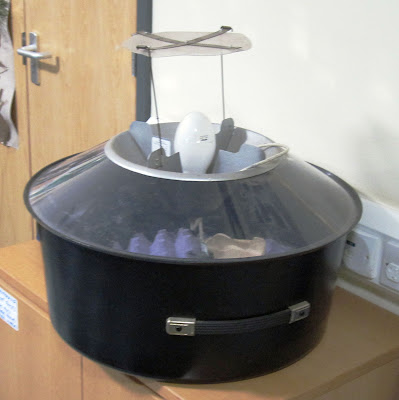 |
| Large and small moths presented by Paul Sokoloff |
This was very enjoyable. Paul is a confident and relaxed speaker who is clearly an expert.
Although he didn't give details, a web search shows that he is a Fellow of the Royal Entomological Society and writes for the Journal of Variation, currently a publication of the Amateur Entomologists' Society. And he takes excellent photos, using a 105mm macro lens with a ring flash.
My own photos in this article are poor quality, because they were taken in low light conditions. But they give the idea. I was pleased to see that moon moth because moonmoth is my user name in several places.
Those two very large moths are not native to Bromley, but apparently a moon moth was taken locally about 20 years ago .. probably bred by someone locally and released or escaped. All the others in the photo were native to, and taken in, the Bromley area.
 |
| A moth trap that can be plugged into the mains supply - not very portable |
Paul is not a compulsive moth killer. The usual procedure is to capture, examine, photograph and release them.
Random facts:
— There are just under 500 species of moths to be found in High Elms Country Park.
— The thing that burrows through horse-chestnut leaves so that they are all brown and dead by the end of the season is a moth, the Horse-Chestnut Leaf Miner; it was discovered in 1952 in Macedonia, and was scarce; it arrived in the UK 10 years ago and is now common.
— The Cinnabar moth caterpillar eats ragwort. The moth is nationally endangered, but its food is a notifiable weed, poisonous to horses, leading to something of a conflict of interests, though not usually embodied in a single person. (Actually there is no longer such a thing as a "notifiable weed," but ragwort is still poisonous and there is a code of practice on preventing its spread.)
— A moth called the Beautiful Snout eats bilberry, which surprisingly can be found on the heathland of Keston Common (which is a remarkable place).
All accompanied by beautiful photos taken by Paul S. himself. He did also show live specimens of four moth species; he would have brought more, but that's all that could be trapped this early in the year.
No comments:
Post a Comment